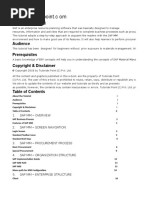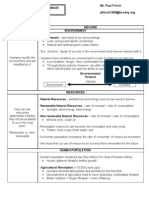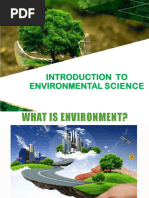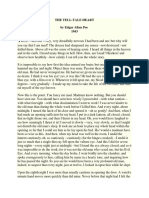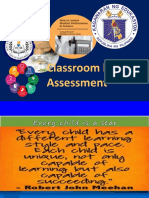0 ratings0% found this document useful (0 votes)
19 viewsReviewer - Science
Reviewer - Science
Uploaded by
Ivan CaroEnvironmental science studies how the natural world works and how the environment affects and is affected by humans. It aims to develop a sustainable world where resources can support human populations indefinitely. While populations have grown exponentially, resources have not, so more people now suffer from shortages. Both renewable and non-renewable resources can be depleted if not managed properly through conservation and recycling. Environmental education teaches people to preserve resources for current and future generations.
Copyright:
© All Rights Reserved
Available Formats
Download as DOCX, PDF, TXT or read online from Scribd
Reviewer - Science
Reviewer - Science
Uploaded by
Ivan Caro0 ratings0% found this document useful (0 votes)
19 views2 pagesEnvironmental science studies how the natural world works and how the environment affects and is affected by humans. It aims to develop a sustainable world where resources can support human populations indefinitely. While populations have grown exponentially, resources have not, so more people now suffer from shortages. Both renewable and non-renewable resources can be depleted if not managed properly through conservation and recycling. Environmental education teaches people to preserve resources for current and future generations.
Original Title
reviewer - science
Copyright
© © All Rights Reserved
Available Formats
DOCX, PDF, TXT or read online from Scribd
Share this document
Did you find this document useful?
Is this content inappropriate?
Environmental science studies how the natural world works and how the environment affects and is affected by humans. It aims to develop a sustainable world where resources can support human populations indefinitely. While populations have grown exponentially, resources have not, so more people now suffer from shortages. Both renewable and non-renewable resources can be depleted if not managed properly through conservation and recycling. Environmental education teaches people to preserve resources for current and future generations.
Copyright:
© All Rights Reserved
Available Formats
Download as DOCX, PDF, TXT or read online from Scribd
Download as docx, pdf, or txt
0 ratings0% found this document useful (0 votes)
19 views2 pagesReviewer - Science
Reviewer - Science
Uploaded by
Ivan CaroEnvironmental science studies how the natural world works and how the environment affects and is affected by humans. It aims to develop a sustainable world where resources can support human populations indefinitely. While populations have grown exponentially, resources have not, so more people now suffer from shortages. Both renewable and non-renewable resources can be depleted if not managed properly through conservation and recycling. Environmental education teaches people to preserve resources for current and future generations.
Copyright:
© All Rights Reserved
Available Formats
Download as DOCX, PDF, TXT or read online from Scribd
Download as docx, pdf, or txt
You are on page 1of 2
LESSON 1 : INTRODUCTION TO Perpetually available: sunlight, wind, wave
ENVIRONMENTAL SCIENCE energy. Renew themselves over short periods of
time: timber, water, soil. These can be destroyed.
ENVIRONMENT: THE TOTAL OF OUR Non-renewable resources:
SURROUNDINGS can be depleted - Oil, coal, minerals.
Living things - Animals, plants, forests, fungi,
etc. The world’s human population has tripled in the
Non-living things - Continents, oceans, clouds, twentieth century, but supplies of food and other
soil, rocks. resources do not grow. Hence, more people
Our Built Environment - Buildings, human- suffer from shortage or scarcity of resources
created living centers. needed for life. Both renewable and non-
Social relationships and institutions. renewable can be created or replaced.
Replacement costs more than what can be
Humans exist within the environment and are created. Conservation and recycling, therefore,
part of nature. Our survival depends on a are the most economical ways to prevent the
healthy, functioning planet. depletion of our resources.
Humans depend completely on the environment
for survival. But natural systems have been Environmental Education is the process by which
degraded. people develop awareness, knowledge, and
concern of the environment and its diverse
Environmental science is the study of: values and processes, and learn to use this
- How the natural world works understanding to preserve, conserve and utilize
- How the environment affects humans and vice the environment in a sustainable manner for the
versa. benefits of present and future generations.
- With environmental problems come
opportunities for solutions. GLOBAL HUMAN POPULATION GROWTH -
More than 7 billion humans.
GOALS OF ENVIRONMENTAL SCIENCE Agricultural revolution - Stable food supplies
To develop a sustainable world, a world in which Industrial revolution - Urbanized society
the supply of food water, building materials, powered by fossil fuels, Sanitation and
clean air, and other resources can sustain Medicines, More food.
human population to continue to exist indefinitely
with a high standard of living and health. To Thomas Malthus
study environmental problems and issues, • Population growth must be controlled, or it will
priorities regarding acceptable environmental outstrip food production. Starvation, war,
preservation of natural species and habitats, disease.
freedom of nations to do as they please, within Neo-Malthusians
their own potential boundaries and issues on the • Population growth has disastrous effects.
quality of life, fairness and ethics. Agricultural advances have only postponed
crises.
NATURAL RESOURCES = Substances and Garret Hardin’s “tragedy of the commons” (1968)
Energy Sources needed for survival. Unregulated exploitation causes resource
Renewable resources: depletion. Everyone takes what he or she can
until the resource is depleted.
Solutions:
Private ownership - Anything not providing benefit to people has no
Voluntary organization to enforce value
responsible use Biocentrism: certain living things also have value
Governmental regulations - All life has ethical standing
ECOLOGICAL FOOTPRINT - Development is opposed if it destroys life, even
The environmental impact of a person or if it creates jobs
population Ecocentrism: whole ecological systems have
- Amount of biologically productive land + water value
- For resources and to dispose/recycle waste - Values the well-being of species, communities,
Overshoot: humans have surpassed the Earth’s or ecosystems
capacity to support us. - Holistic perspective, stresses preserving
connections.
We are using 30% more of the planet’s
resources than are available on a sustainable PRESERVATION ETHICS - Unspoiled nature
basis! The human footprint measures energy should be protected for its own inherent value.
quantities, resources, and products consumed by CONSERVATION ETHICS - Use natural
a human during his/her lifetime and includes, for resources wisely for the greatest good for the
example, the number of food “pieces,” the most people.
volumes of fuel and water, and the mass of LAND ETHICS - Healthy ecological systems
waste. depend on protecting all parts.
ENVIRONMENTAL SCIENCE IS NOT ECOFEMINISM - In the 1960s and 1970s,
ENVIRONMENTALISM feminist scholars saw parallels in how people
treated nature and how men treated women.
Ethics: the study of good and bad, right and ENVIRONMENTAL JUSTICE (EJ) - Involves the
wrong. The set of moral principles or values held fair treatment of all people with respect to the
by a person or society that tells us how we ought environment, regardless of race, income, or
to behave. ethnicity. The poor and minorities are exposed to
Relativists: ethics vary with social context. more pollution, hazards, and environmental
Universalists: right and wrong remains the same degradation.
across cultures and situations.
Ethical standards: criteria that help differentiate SUSTAINABILITY - A guiding principle of
right from wrong environmental science.
- Classical standard = virtue Natural capital: the accumulated wealth of Earth
- The golden rule: treat others as you want to be Sustainable development: using resources to
treated satisfy current needs without compromising
Utility: something right produces the most future availability of resources.
benefits for the most people Sustainable solutions must meet:
Environmental ethics: application of ethical - Environmental goals
standards to relationships between human and - Economic goals
non-human entities - Social goals
Anthropocentrism: only humans have rights
- Costs and benefits are measured only
according to their impact on people
You might also like
- Cape History Unit One Comple Class Notes STGCDocument158 pagesCape History Unit One Comple Class Notes STGCJoshua Black100% (2)
- Environmental Science Lecture NotesDocument26 pagesEnvironmental Science Lecture Notesjed.berdosNo ratings yet
- Environmental EthicsDocument2 pagesEnvironmental EthicsRonnel Pardos100% (2)
- Sap MM Config TutorialDocument78 pagesSap MM Config TutorialSAYANDEEP MITRA50% (2)
- Es NoteDocument3 pagesEs NoteAnh ThiNo ratings yet
- Es Note 1Document3 pagesEs Note 1Vy NguyễnNo ratings yet
- Philo 1Document10 pagesPhilo 1rasonabe.kristineaeyaNo ratings yet
- Environmental ScienceDocument17 pagesEnvironmental ScienceLanceNo ratings yet
- GE ELEC 02 LectureDocument28 pagesGE ELEC 02 LectureChristine Joy BaluconNo ratings yet
- Environmental EthicsDocument7 pagesEnvironmental Ethicsrupalisharma871307No ratings yet
- Environmental-Science-reviewerDocument7 pagesEnvironmental-Science-reviewerannluste20No ratings yet
- The Human Person in Their EnvironmentDocument23 pagesThe Human Person in Their Environmentmitzi lavadiaNo ratings yet
- Environmental Science ReviewDocument9 pagesEnvironmental Science ReviewVictoria ArrudaNo ratings yet
- Pee and Sts ReviewerDocument16 pagesPee and Sts Reviewerracelisprincess328No ratings yet
- Environmental Ethics and Sustainable Development: Yamini B 191003062 Iv Year, Chemical Engineering DepartmentDocument10 pagesEnvironmental Ethics and Sustainable Development: Yamini B 191003062 Iv Year, Chemical Engineering DepartmentYamini BNo ratings yet
- Environmental Ethics: Need To RethinkDocument3 pagesEnvironmental Ethics: Need To RethinkDr A.K. VermaNo ratings yet
- What Is The EnvironmentDocument6 pagesWhat Is The EnvironmentJoanah FernandezNo ratings yet
- LESSON-7_044242Document6 pagesLESSON-7_044242santillanmj8No ratings yet
- Chapter 1 Environmental Problems Their Causes and SustainabilityDocument43 pagesChapter 1 Environmental Problems Their Causes and Sustainabilitygwapak83No ratings yet
- Module-I-Lesson-2 (1)Document7 pagesModule-I-Lesson-2 (1)charlesjoshuaalvarez19No ratings yet
- Sustainability and Human Values: Lecture Notes 2Document4 pagesSustainability and Human Values: Lecture Notes 2Princess NobleNo ratings yet
- Introduction To Environmental ScienceDocument47 pagesIntroduction To Environmental ScienceEljhon Satsat100% (1)
- LESSON-4-Philo-of-Human-Person-Man-EnvironmentDocument20 pagesLESSON-4-Philo-of-Human-Person-Man-Environmenty.caranto.tolentinoNo ratings yet
- Chapter 1 - Introduction To Environmental ScienceDocument56 pagesChapter 1 - Introduction To Environmental ScienceAnne PinoteNo ratings yet
- Cornell Notes Read AlongDocument4 pagesCornell Notes Read AlonggrantgoodyNo ratings yet
- Environmental PhilosophyDocument2 pagesEnvironmental Philosophy23102853No ratings yet
- Presented By: Prateek Arora Roll No. 5261 Mba - IDocument15 pagesPresented By: Prateek Arora Roll No. 5261 Mba - ISahil MittalNo ratings yet
- Environmental Sci Chap 1Document39 pagesEnvironmental Sci Chap 1Alven Bautista CalapeNo ratings yet
- Lesson 4: Human Person and His EnvironmentDocument7 pagesLesson 4: Human Person and His EnvironmentJomel BermasNo ratings yet
- 1 IntroductionDocument19 pages1 IntroductionYhan Mendoza NañascaNo ratings yet
- Environmental Science ReviewerDocument5 pagesEnvironmental Science ReviewerCris OntogNo ratings yet
- Local Media7836383884627581088Document6 pagesLocal Media7836383884627581088russeldabon24No ratings yet
- Module 1 OoooDocument5 pagesModule 1 OoooJIREH MAE JAVIERNo ratings yet
- Earth's Atmosphere: Culture SocietyDocument9 pagesEarth's Atmosphere: Culture SocietyGavin FabeliñaNo ratings yet
- The Human ENVIRONMENTDocument50 pagesThe Human ENVIRONMENTKay EdicaNo ratings yet
- Lesson 12 Intro Env.educ. 2Document23 pagesLesson 12 Intro Env.educ. 2Ritchiel Joy SupranesNo ratings yet
- 5th Sem - Environmental Psy & HR (EPHR) - Module 1-MG Unvsty - PEPPGUIDEDocument17 pages5th Sem - Environmental Psy & HR (EPHR) - Module 1-MG Unvsty - PEPPGUIDEswathy sudheerNo ratings yet
- Living in The Environment (Chapter 1-3) CompleteDocument8 pagesLiving in The Environment (Chapter 1-3) CompleteJessel Mae De LunaNo ratings yet
- ENVI - Lesson 1 IntroDocument2 pagesENVI - Lesson 1 IntroCrizel Marbella BoncayNo ratings yet
- Eth600 - Business Ethics - Unit ViiiDocument37 pagesEth600 - Business Ethics - Unit Viiinicola.jenkinslewis18No ratings yet
- Introduction To Environmental ScienceDocument50 pagesIntroduction To Environmental ScienceJhaykhaye VilbarNo ratings yet
- It EraDocument6 pagesIt EraleixxaneNo ratings yet
- GKC-181 Report On Environmental Studies-Natural Resources: Dayalbagh Educational InstituteDocument34 pagesGKC-181 Report On Environmental Studies-Natural Resources: Dayalbagh Educational Institutesinghjanhavi1001No ratings yet
- CHAPTER 1 - Miller 1 PDFDocument74 pagesCHAPTER 1 - Miller 1 PDFbrodyNo ratings yet
- Module 6 DR RP Sustainability, Ethics, Consumerism and PopulationDocument51 pagesModule 6 DR RP Sustainability, Ethics, Consumerism and Populationtameshbhave1No ratings yet
- 1.1. Environmental Principles: Interdependence and InterconnectednessDocument21 pages1.1. Environmental Principles: Interdependence and InterconnectednessRis LangbayNo ratings yet
- 1-Nature of Env SystemDocument56 pages1-Nature of Env SystemaditikaushikNo ratings yet
- EnvironmentDocument8 pagesEnvironmentSneha YadavNo ratings yet
- Evs For Bba NotesDocument22 pagesEvs For Bba NotesGaurav100% (1)
- Lesson 1 - IntroductionDocument23 pagesLesson 1 - IntroductionRoseann BalanaNo ratings yet
- Ecology-and-EnvironmentalismDocument8 pagesEcology-and-EnvironmentalismborlazaavegailNo ratings yet
- The Multidisciplinary Nature of Environmental StudiesDocument34 pagesThe Multidisciplinary Nature of Environmental StudiesPoornima RajpalNo ratings yet
- Unit 1-Environmental Science LectureDocument7 pagesUnit 1-Environmental Science LectureSamrudhi Patil100% (1)
- WEEK 3_Environmental PrinciplesDocument3 pagesWEEK 3_Environmental PrinciplesAnew YouNo ratings yet
- People and Earths EcosystemDocument4 pagesPeople and Earths EcosystemJolina T. OrongNo ratings yet
- Lesson 4 Reporter (Villanueva, Singson, Belarmino)Document55 pagesLesson 4 Reporter (Villanueva, Singson, Belarmino)Kirby ZaragozaNo ratings yet
- Introduction To Environmental ScienceDocument8 pagesIntroduction To Environmental ScienceLovely's GoodiesNo ratings yet
- Grow Herbs, Fruits and Vegetables in 5 Easy Steps: Permaculture for BeginnersFrom EverandGrow Herbs, Fruits and Vegetables in 5 Easy Steps: Permaculture for BeginnersNo ratings yet
- HANDBOOK 101: A Guide to Sustainability for the Individual ConsumerFrom EverandHANDBOOK 101: A Guide to Sustainability for the Individual ConsumerNo ratings yet
- Vegan Alien Intelligence: Terraforming A New Universe Starts With The EarthFrom EverandVegan Alien Intelligence: Terraforming A New Universe Starts With The EarthNo ratings yet
- CREDIT-CARD (MLY-Sep 27,2023AC#0000000000070761)Document4 pagesCREDIT-CARD (MLY-Sep 27,2023AC#0000000000070761)Zahid5391No ratings yet
- Dynamical Analysis of A Novel Single Opamp-Based Autonomous LC Oscillator: Antimonotonicity, Chaos, and Multiple AttractorsDocument15 pagesDynamical Analysis of A Novel Single Opamp-Based Autonomous LC Oscillator: Antimonotonicity, Chaos, and Multiple AttractorsTSAFACK NESTORNo ratings yet
- ChallanDocument1 pageChallanjanaaab5068No ratings yet
- 4.-Supervise-Work-Based-Training-FINAL MJDocument56 pages4.-Supervise-Work-Based-Training-FINAL MJMARY JANENo ratings yet
- Maintenance of Training Facilities: Bartending NC IiDocument25 pagesMaintenance of Training Facilities: Bartending NC IiFRELYNNo ratings yet
- BARANGAY DEVELOPMENT PLANNING FORMULATION WORKSHOP ProgramDocument3 pagesBARANGAY DEVELOPMENT PLANNING FORMULATION WORKSHOP ProgramJetro ResonarNo ratings yet
- Solid Waste Dumping Site Suitability AnaDocument5 pagesSolid Waste Dumping Site Suitability AnaRashi GuptaNo ratings yet
- Muhammad Kafayat: Personal ProfileDocument2 pagesMuhammad Kafayat: Personal ProfileArslan AzharNo ratings yet
- Aggravated RobberyDocument6 pagesAggravated Robberyanne100% (2)
- Life Span PorfolioDocument7 pagesLife Span PorfolioSiu GongNo ratings yet
- QazxDocument21 pagesQazxDavid Con RiveroNo ratings yet
- HS Honeywell Titan Scba Niosh HSPRSP 212ind Brochure Titan Nfpa-Scba Final NewDocument8 pagesHS Honeywell Titan Scba Niosh HSPRSP 212ind Brochure Titan Nfpa-Scba Final NewNgô Thanh TânNo ratings yet
- Psychological Tests and Apparatus.A ListDocument29 pagesPsychological Tests and Apparatus.A Listanagha_go0% (1)
- Cramer Understanding Defense MechanismsDocument30 pagesCramer Understanding Defense MechanismsTiberiu100% (1)
- PDF Rodolfo Vs People GR No 146964Document2 pagesPDF Rodolfo Vs People GR No 146964emen penaNo ratings yet
- SpeechDocument1 pageSpeechKrissa Jean KingNo ratings yet
- Monistic and Pluralistic Sovereignty. Short NotesDocument3 pagesMonistic and Pluralistic Sovereignty. Short NotesMuzafar SoomroNo ratings yet
- Diagnosis of Poisoning in Living and Dead Person: Dr. Khan Singh AmeraDocument3 pagesDiagnosis of Poisoning in Living and Dead Person: Dr. Khan Singh AmeraSandeep SinghNo ratings yet
- E Commerce FIA Memory AidDocument5 pagesE Commerce FIA Memory Aidangelica arnaizNo ratings yet
- Come Awake Oh My SoulDocument7 pagesCome Awake Oh My SoulFlorence Tri Utami LatuharharyNo ratings yet
- Obstructed LabourDocument2 pagesObstructed LabourAvinash BarhateNo ratings yet
- By The Board of Directors and Stockholders of RHL Lending Inc. July 15, 2019 Board Resolution No. 2019-012Document17 pagesBy The Board of Directors and Stockholders of RHL Lending Inc. July 15, 2019 Board Resolution No. 2019-012Michael Vincent BautistaNo ratings yet
- Introduction PDFDocument5 pagesIntroduction PDFPutry AryaniNo ratings yet
- Menasco - Art Aero Digest 1936Document9 pagesMenasco - Art Aero Digest 1936virtualbobNo ratings yet
- Slac Classroombased AssessmentDocument61 pagesSlac Classroombased AssessmentSheChanNo ratings yet
- Using Primary Documents in Social Studies and HistoryDocument13 pagesUsing Primary Documents in Social Studies and Historydavidizanagi100% (1)
- Chapter VI Lecture NoteDocument14 pagesChapter VI Lecture NotegereNo ratings yet
- Compound Words in Spanish Theory and History CompressDocument479 pagesCompound Words in Spanish Theory and History CompressJoel Arturo Pedraza NicolasNo ratings yet



